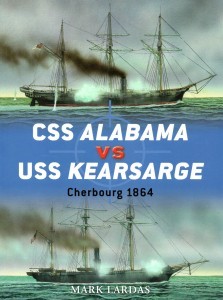 By Mark Lardas, Osprey Publishing, (2011)
By Mark Lardas, Osprey Publishing, (2011)
Reviewed by Thomas P. Ostrom
The author, Mark Lardas, brings a degree in naval architecture and marine engineering to his analysis of this epic American Civil War naval battle; as well as experience in writing as a military historian, and ship modeler. The book is enhanced with magnificent illustrations by ship modeler and war gamer Peter Dennis.
Seamanship on the high seas; American Civil War (1861-1865) diplomacy; seaman, warrant and commissioned officer rates, ranks and duties; training; provisions; ship building, construction, and purchasing techniques; ordnance and armament; and the biographies of captains John Winslow (USS Kearsarge) and Raphael Semmes (CSS Alabama) are superbly and eloquently traced to provide the reader with riveting context, background, and analysis.
Lardas ably traces the evolution of warships from the War of 1812-1814 wooden hull sail ships, to the heterogeneous composites of wood, copper and iron hulled coal fired steam and screw (propeller) powered leviathans of 200-feet or more; armed with smooth bore and rifled (grooved) muzzle and breech loaded cannons. Some cannons were wheeled and at port and starboard hull gun port stations, others were more permanent pivot cannons at the ship midline; and stern and bow guns were positioned. The most formidable gun on Union warships was the Dahlgren cannon of various muzzle sizes, often 11 inches.
The age of steam required ships of deeper draft and wider breadth to accommodate engine rooms, coal storage, and more powerful guns. Auxiliary vessels (steam for maneuverability, sail for fuel economy) possessed two and four blade screws, and some maintained target-vulnerable side and rear paddle wheels more suitable for river and coastal than transoceanic voyages.
Enriched by his nautical engineering and history background, Mark Lardas chronicled the 18th and 19th century evolution of wooden ship tactics, logistics, wooden hull construction (functional for absorbing cannon balls and explosive fuse shells), and the addition of iron frames and copper bottoming to protect subsurface hulls from physical impact and marine floral and faunal accumulation. Wooden ship hulls, Lardas wrote, changed from basic parallel wood frames to additional transverse, diagonal, and vertical support systems for added strength and protection against hull movement and warping.
The imminent dangers of injury and death to nautical warriors were sinking vessels, burns and explosions from guns and steam machinery, and the flying splinters and daggers emanating from shattered wooden hulls under cannon and shellfire impact. Seamen and line officers had to learn gunnery. On some Union vessels, members of the United States Marine Corps, the maritime soldiers and police with U.S. Army ranks and rates, supplemented naval gun crews.
Especially interesting were the author’s biographical summaries of the nautical protagonists, Winslow and Semmes. The two naval officers served together in the United States-Mexico War (1846-1848). Lardas seemed to suggest that their reciprocal service and familiarity might have influenced Winslow’s actions or lack thereof in the final battle and response to the sinking of the Alabama and the fate of Semmes and his crew adrift at sea.
The reader will be mesmerized by the highlights of the June 1864 battle between Kearsarge and the Confederate commerce raider Alabama, six miles off the French port of Cherbourg in international waters.
Equally intriguing, the post-war careers of Winslow and Semmes, and the fate of USS Kearsarge.
Lardas writes like a novelist, and the maritime history and technology expert that he is. The book is a compelling and informative read.
Thomas Ostrom is retired college history instructor, former member of the USCGR, and author of 4 books on U.S. Coast Guard history, most recently The United States Coast Guard in World War II (McFarland Publ. Co., 2009) and The United States Coast Guard in National Defense (McFarland, 2012)

